10 Essential Insights for Effective Retail Data Analysis

10 Essential Insights for Effective Retail Data Analysis
Introduction
Retail data analysis is rapidly transforming the retail industry, providing businesses with unprecedented access to a wealth of information that can drive strategic decision-making. This evolution is marked by the anticipated rise in the use of alternative datasets, which presents organizations with a unique opportunity to deepen their understanding of consumer behavior and market dynamics. However, as the volume of data continues to grow, the challenge lies in effectively harnessing these insights to optimize operations and enhance customer experiences.
What essential strategies can retailers adopt to navigate this data-driven world? By leveraging alternative datasets, retailers can gain valuable insights that not only inform their strategies but also improve their overall performance. For instance, analyzing customer purchasing patterns can reveal trends that help businesses tailor their offerings to meet consumer demands more effectively.
To unlock the full potential of their analytics, retailers should focus on integrating these datasets into their decision-making processes. This involves not just collecting data, but also interpreting it in ways that lead to actionable insights. By doing so, they can enhance their operational efficiency and create more personalized customer experiences.
In this context, it’s crucial for retailers to ask themselves:
- How can these insights be applied to improve our strategies?
By embracing a data-driven approach, businesses can position themselves to thrive in an increasingly competitive landscape.
Initial Data Offering: Access Diverse Retail Datasets for Analysis
Initial Data Offering (IDO) is a crucial resource that provides a diverse array of retail information, including alternative information, fundamentals information, and ESG information. This variety empowers analysts to explore multiple facets of retail performance, consumer behavior, and market dynamics using retail data analysis. As a result, organizations can make more strategic decisions based on comprehensive insights.
In 2025, it's anticipated that around 67% of businesses will utilize alternative information for retail data analysis. This statistic underscores the growing importance of alternative datasets in the industry. By leveraging IDO's marketplace, organizations can access unique datasets tailored to their analytical needs, enhancing their competitive edge in a rapidly evolving market.
Recent trends indicate that the integration of alternative information is revolutionizing retail data analysis. Successful applications of these datasets have led to improved insights and operational efficiencies. The emphasis on diverse datasets is essential for retail data analysis, as they provide a holistic view that drives innovation and informed strategies in the retail landscape.
How can your organization benefit from these insights? By embracing the wealth of information available through IDO, businesses can position themselves for success in an increasingly data-driven world.
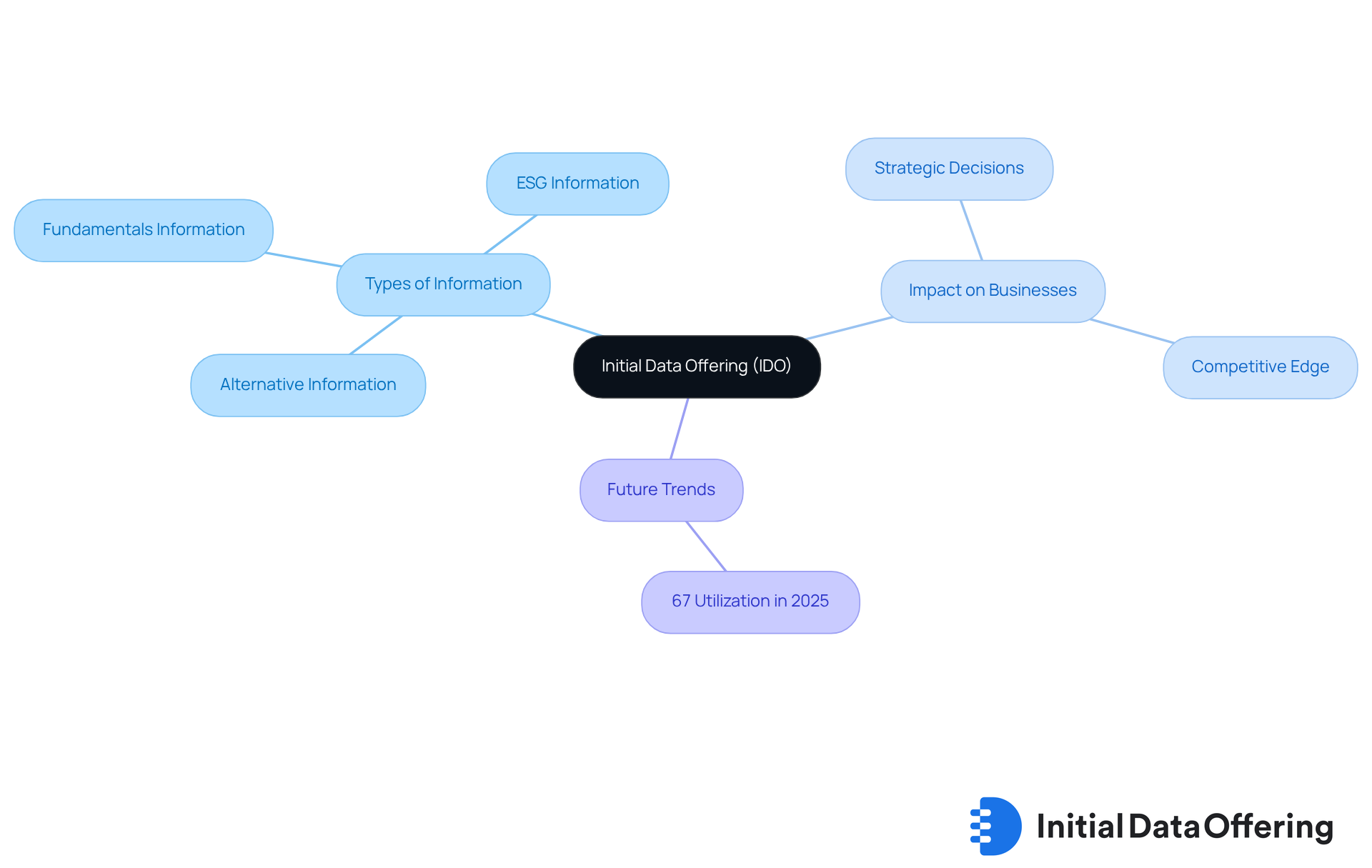
Understanding Retail Analytics: Key Concepts and Importance
Retail data analysis includes the systematic gathering, examination, and interpretation of information related to retail operations. This process encompasses several key concepts:
- Descriptive analytics summarizes past performance, providing a clear picture of what has happened.
- Diagnostic analytics explains why certain outcomes occurred, helping retailers understand the factors at play.
- Predictive analytics forecasts future trends, allowing businesses to anticipate changes in the market.
- Prescriptive analytics advises actions based on insights, guiding retailers on the best steps to take moving forward.
Understanding these concepts is crucial for retailers aiming to optimize their strategies and enhance customer experiences through retail data analysis. How can these analytics transform your approach to retail? By leveraging insights from retail data analysis, retailers can make informed decisions that not only improve operational efficiency but also elevate customer satisfaction. The ability to analyze past performance, understand underlying causes, predict future trends, and prescribe actionable strategies empowers retailers to stay competitive in a rapidly evolving market.
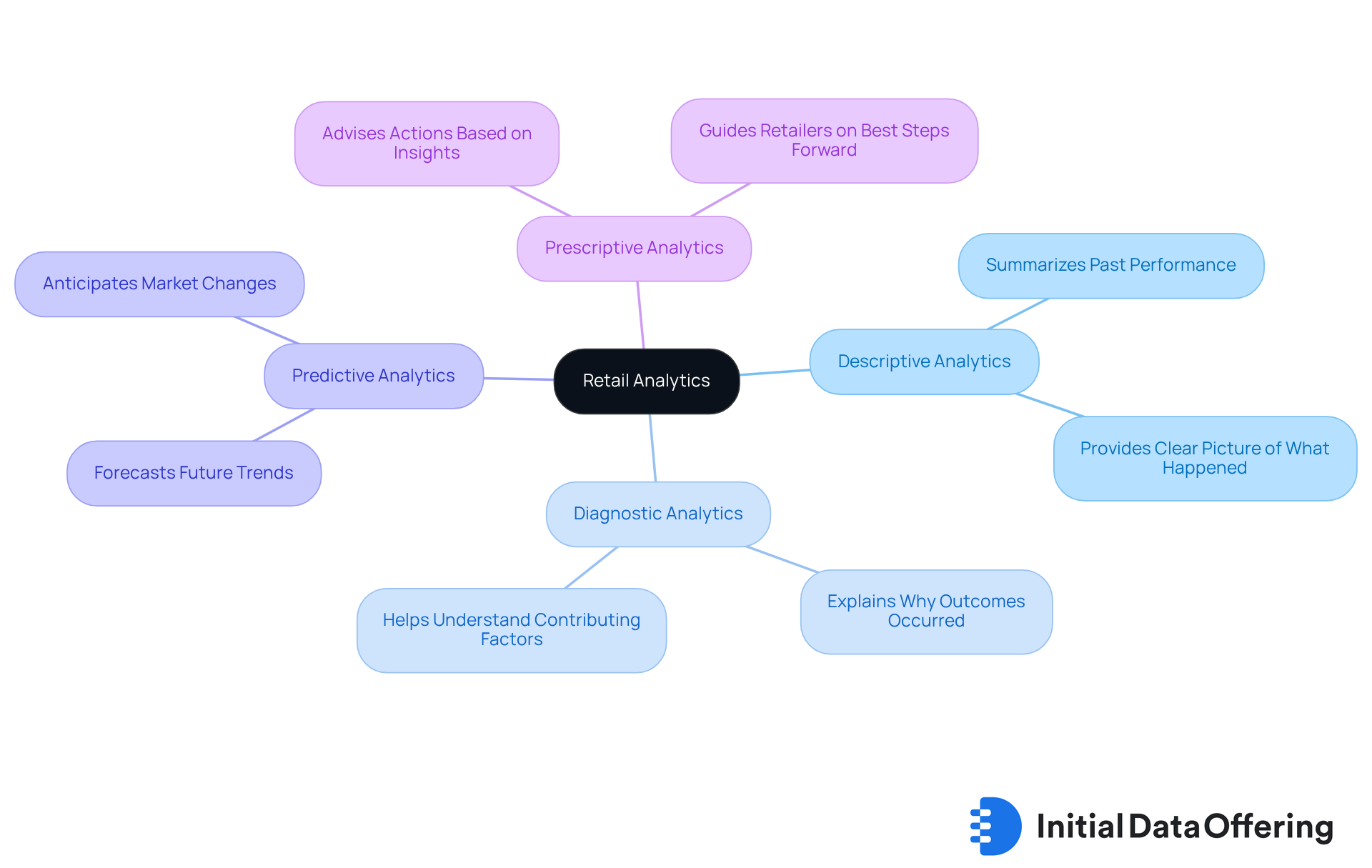
Types of Data Analysis in Retail: Methods and Techniques
In retail, several methods of retail data analysis are commonly employed, each serving a unique purpose that can significantly impact decision-making.
-
Descriptive Analysis: This method summarizes historical data, allowing retailers to identify trends and patterns. By understanding past behaviors, businesses can make informed decisions that align with customer preferences. The advantage here is that it provides a clear picture of what has happened, which is essential for strategic planning.
-
Diagnostic Analysis: This approach investigates the reasons behind past performance. It digs deeper into the data to uncover the factors that influenced outcomes. The benefit of diagnostic analysis is that it helps retailers understand not just what happened, but why it happened, enabling them to address issues effectively.
-
Predictive Analysis: Utilizing historical information, this method forecasts future outcomes. Retailers can anticipate customer behavior and market trends, which allows for proactive strategies. The advantage lies in its ability to inform inventory management and marketing efforts, ultimately driving sales.
-
Prescriptive Analysis: This method suggests actions based on predictive insights. By analyzing potential scenarios, retailers can make data-driven decisions that optimize operations. The benefit is clear: it empowers businesses to take informed actions that enhance performance and profitability.
Each of these methods can be applied depending on the specific goals of the retail data analysis. How might these analytical approaches transform your retail strategy?
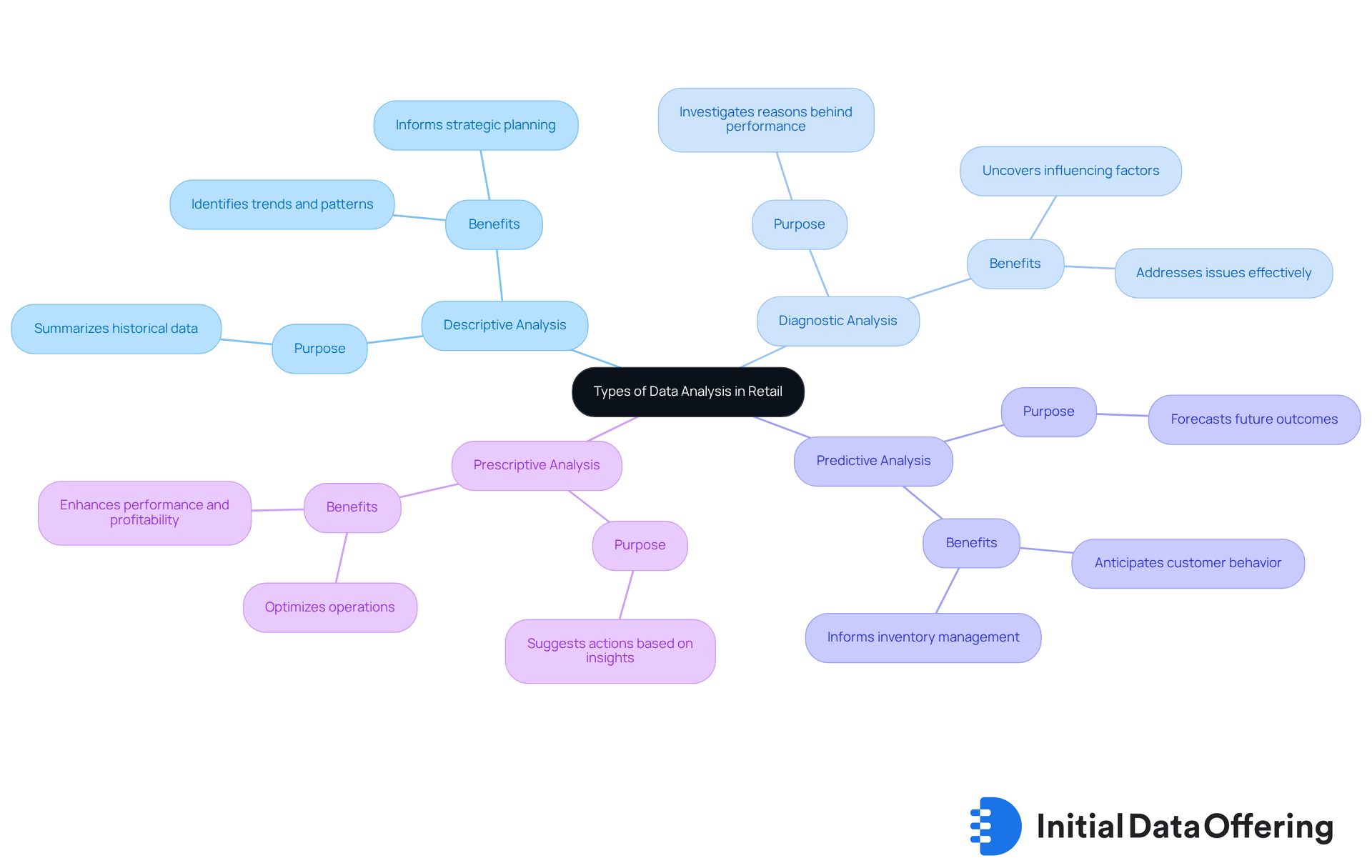
Benefits of Retail Analytics: Enhancing Business Strategies
Retail analytics offers a range of advantages that significantly enhance business strategies:
-
Improved Decision-Making: Retailers can leverage data-driven insights to make informed choices. In fact, 91% of businesses recognize the critical role of data in their decision-making processes. Yet, only 57% effectively utilize the available data. This gap between belief and practice is something sellers must address to improve their outcomes.
-
Enhanced Shopper Experience: By examining consumer preferences and behaviors, retailers can implement personalized marketing strategies that resonate with individual buyers. This hyper-personalization not only boosts customer satisfaction but also fosters loyalty. Companies that customize experiences are more likely to retain clients, making this approach essential for long-term success.
Operational efficiency can be improved as retail data analysis pinpoints inefficiencies within supply chains and inventory management systems. Organizations that adopt data-driven strategies are 23 times more likely to attract new customers and 19 times more likely to be profitable. This showcases how streamlined operations can significantly impact overall business success.
- Increased Sales: Predictive data analysis allows retailers to accurately forecast trends and consumer behavior, leading to optimized pricing and promotional strategies. Companies utilizing predictive information analysis have reported an average revenue growth of 15%. It's noteworthy that 50% of all business decisions rely on information, yet only half of the accessible information in organizations is utilized. This highlights the necessity for improved information utilization.
Together, these benefits enhance a retailer's market position, demonstrating that effective retail data analysis is vital for success in today's competitive landscape. As Peter Sondergaard aptly stated, "Data is useless until it’s mined and handled in the right way." This reinforces the importance of proper data analysis in driving business success.
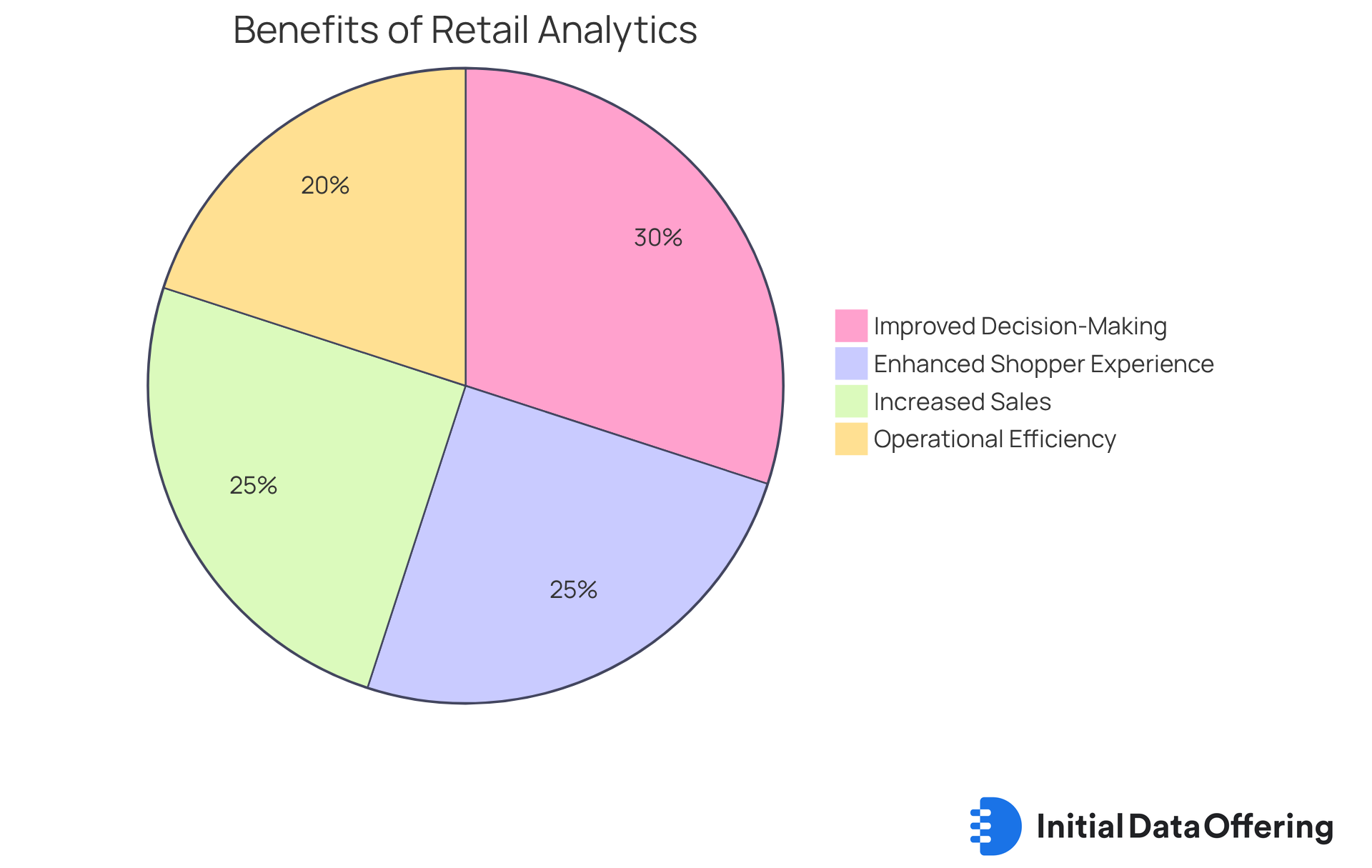
Improving Customer Insights: Leveraging Retail Analytics
Through retail data analysis, businesses gain valuable insights into consumer behavior by thoroughly examining purchasing patterns, preferences, and feedback. Understanding diverse audience segments is crucial for tailoring marketing efforts effectively. For instance, RFM (Recency, Frequency, Monetary) analysis helps identify key segments, allowing businesses to focus on high-value individuals and refine their engagement strategies. Successful merchants have leveraged RFM analysis to enhance client loyalty by customizing offers based on purchasing frequency and monetary value, resulting in increased sales growth.
Furthermore, advanced techniques such as predictive modeling and machine learning algorithms empower retailers to forecast future purchasing patterns and adjust their strategies accordingly. Demand modeling methods can significantly improve operational planning by providing insights into expected client demand based on historical data.
As Annette Franz emphasizes, having the right information and tools is essential for enhancing client experience. By utilizing these insights, retailers can not only boost client engagement but also cultivate long-term loyalty, ultimately driving sustainable sales growth. The integration of behavioral data with operational insights deepens the understanding of consumer journeys, facilitating more informed decision-making and targeted marketing initiatives.
To begin implementing retail data analysis, such as RFM analysis or predictive modeling in your retail strategies, start with basic data from your POS systems and client interactions. This foundational step can lead to meaningful insights and improved client engagement.
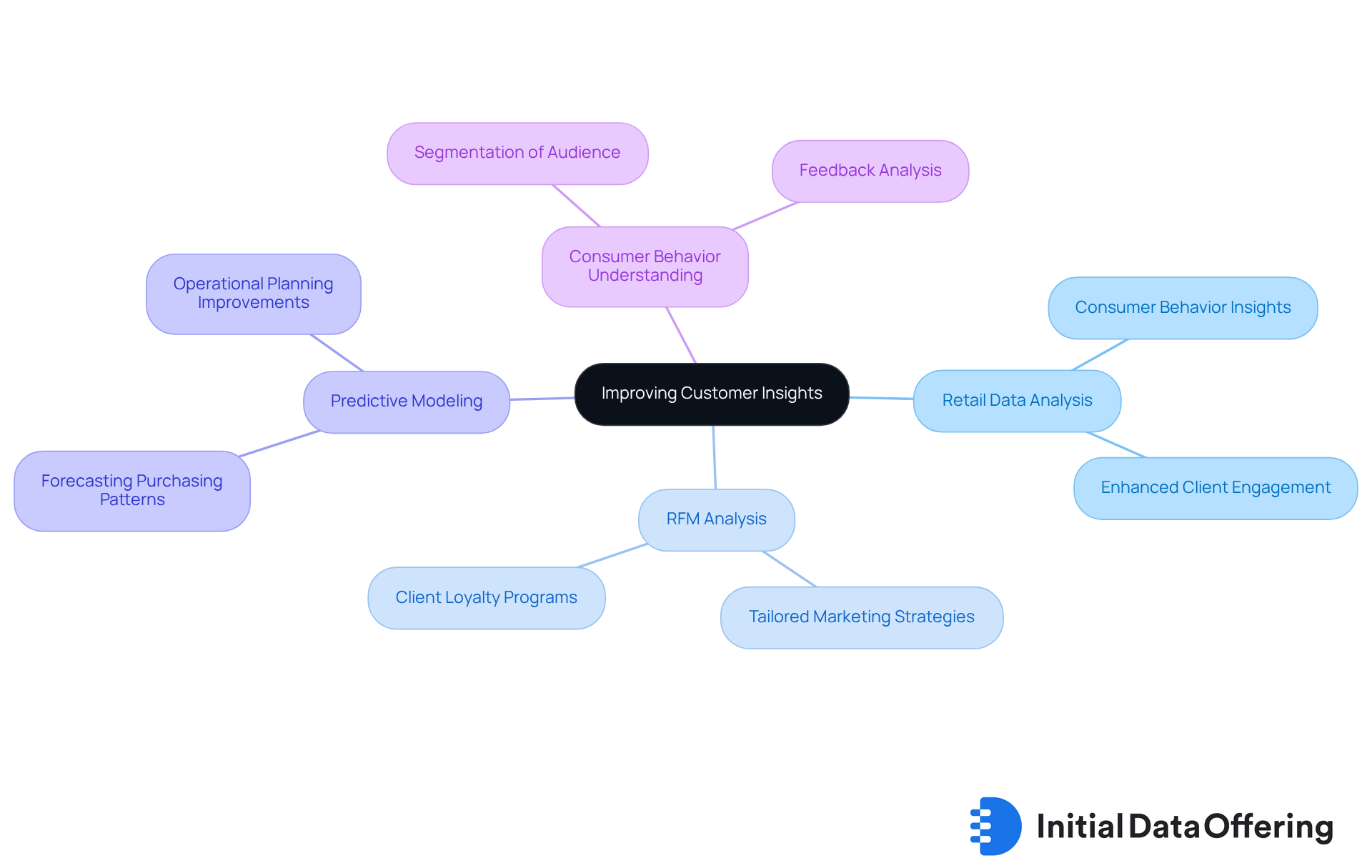
Enhancing Customer Acquisition: Strategies Through Data Analysis
Data analysis is crucial for improving client acquisition strategies. By leveraging predictive analytics through retail data analysis, retailers can pinpoint potential buyers and customize marketing campaigns to draw them in. Techniques such as A/B testing and journey mapping allow companies to refine their outreach strategies, ensuring they engage the right audience with the right message at the right time. This targeted approach not only boosts conversion rates but also reduces acquisition costs, which have surged by 222% over the past eight years, demonstrating the effectiveness of retail data analysis.
Companies that utilize retail data analysis have reported greater targeting accuracy. Krzysztof Wabia emphasizes the benefits of real-time machine learning in forecasting potential trends. Furthermore, showcasing success stories from A/B testing can effectively demonstrate its value in retail marketing. As the retail landscape evolves, nurturing future talent in marketing will be essential for adapting to these changes and maintaining a competitive edge in client acquisition.

Building Customer Loyalty: Insights from Retail Data
Retail data analysis offers essential insights that can significantly enhance client loyalty. By utilizing retail data analysis to examine buyer purchase history and engagement metrics, retailers can develop customized loyalty programs that effectively reward repeat customers. This tailored approach not only acknowledges customer loyalty but also encourages further engagement.
Understanding client feedback and satisfaction levels is equally crucial. It allows businesses to identify areas for improvement in their offerings. By making necessary adjustments based on this feedback, companies can enhance the overall client experience, which is vital for fostering long-term loyalty.
How can your business leverage these insights? Consider implementing data-driven strategies that utilize retail data analysis to focus on customer preferences and behaviors. By doing so, you can create a more personalized shopping experience that resonates with your clients, ultimately leading to increased loyalty and satisfaction.
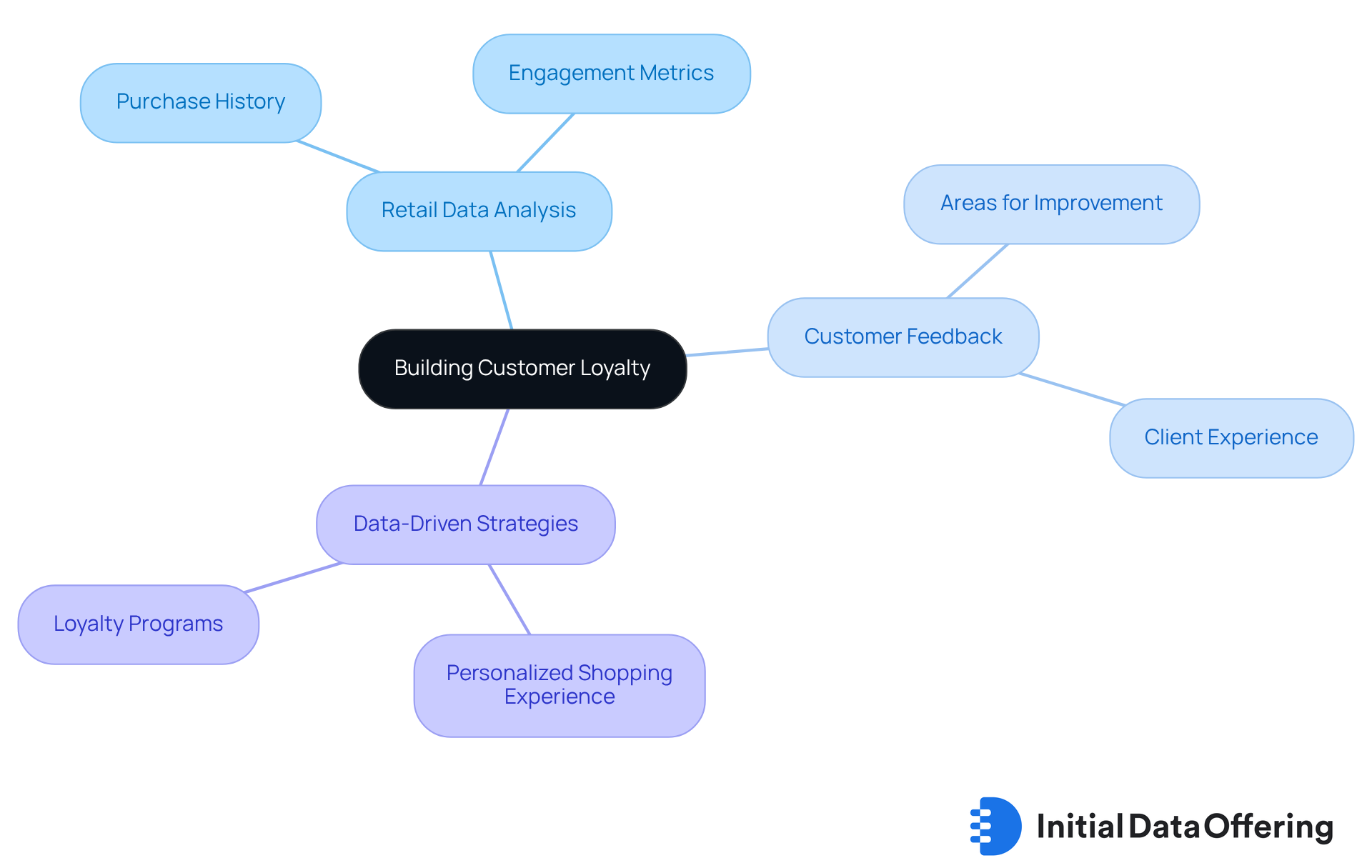
Optimizing Merchandising Strategies: Data-Driven Approaches
Retail data analysis is utilized in data-driven merchandising strategies to enhance product placement and inventory management by leveraging sales data, customer preferences, and market trends. What if you could optimize your inventory based on actual consumer behavior? Market basket analysis is a key component of this approach, as it identifies products that are frequently purchased together. This insight enables sellers to create effective cross-selling opportunities. For example, businesses that have implemented basket analysis techniques have seen a 15% increase in cross-sell sales and a 20% reduction in stockouts.
Moreover, companies leveraging these insights have reported an average increase of $3.4 million in yearly profits. By employing advanced retail data analysis tools, such as the FP-Growth algorithm, retailers can align their merchandising strategies with consumer demand. This alignment not only drives sales but also enhances the overall shopping experience. How can personalized recommendations and targeted promotions improve customer satisfaction?
This method significantly improves inventory management while promoting customer satisfaction. As Bernard Marr highlights, retail data analysis, including basket analysis, is essential for enhancing retail operations and maintaining a competitive edge. By understanding the purchasing patterns of consumers, businesses can make informed decisions that lead to better outcomes.

Advanced Real Estate Planning: Utilizing Retail Analytics
Retail data analysis plays a crucial role in optimizing real estate planning by providing valuable insights into ideal store locations and market potential. What if you could pinpoint the best spots for your next store? By leveraging demographic data, merchants can identify target customer profiles, which is essential for making informed decisions about new store openings. Understanding local demographics helps retailers assess foot traffic patterns and competitive landscapes, ensuring they select locations that align with consumer behaviors and preferences.
Predictive analysis further enhances this process by forecasting future market trends. This allows businesses to anticipate changes in consumer demand and strategically position themselves in high-potential areas. Current trends in demographic analysis highlight the significance of incorporating advanced analytical tools to enhance site selection strategies. Retailers who effectively utilize demographic insights can not only enhance their market presence but also improve operational efficiency and profitability.
Expert insights underscore the importance of demographic data in location decisions. For instance, examining customer demographics and psychographics enables sellers to match their offerings with local expectations, ultimately increasing foot traffic and sales. As the retail landscape evolves, embracing data-driven strategies will be essential for retailers aiming to thrive in competitive markets. Did you know that the worldwide location analysis market is expected to expand from $20.6 billion in 2023 to $38.5 billion by 2028? This emphasizes the growing significance of information assessment in retail site selection.
Moreover, considering co-tenancy analysis and the impact of surrounding businesses can significantly influence a store's performance. The strategic placement of physical stores can enhance online sales through increased visibility. Addressing zoning regulations and local restrictions is also crucial for ensuring operational capabilities and profitability.

Retail Analytics Software and Tools: Essential Resources for Analysts
To effectively leverage retail data analysis, businesses must utilize the appropriate software tools. Key resources include:
-
Tableau: This tool is renowned for its powerful data visualization capabilities. Tableau enables retailers to create interactive dashboards that transform complex data into clear, actionable insights. Its user-friendly interface allows analysts to visualize trends and patterns, facilitating informed decision-making. As businesses strive to customize experiences to individual customer preferences, Tableau's role in enhancing personalization efforts becomes increasingly essential.
-
Microsoft Power BI: Excelling in business intelligence and reporting, Power BI offers real-time insights and comprehensive reporting features. Success stories highlight its role in enhancing operational efficiency and driving strategic initiatives through data-driven insights. The ability to track key performance indicators (KPIs) in real-time makes Power BI essential for adapting to the fast-paced retail environment.
-
SAS: Known for sophisticated data analysis and predictive modeling, SAS enables merchants to anticipate trends and enhance inventory management. Its strong analytical abilities support data-informed strategies that improve profitability and client satisfaction, addressing the competitive pressures businesses face in the market.
-
Google Analytics: Essential for web and e-commerce analytics, Google Analytics helps retailers monitor consumer behavior online. It offers insights into user engagement and conversion rates, which are crucial for enhancing marketing strategies and boosting the overall customer experience, especially when personalization is vital.
These tools collectively empower analysts to conduct retail data analysis, extracting actionable insights from data and facilitating better decision-making and strategic planning. As the retail landscape evolves, the adoption of business intelligence tools like Tableau and Power BI is expected to grow, driven by the need for real-time insights from retail data analysis and enhanced operational effectiveness. Notably, the retail analytics market is projected to reach USD 45.2 billion by 2033, underscoring the importance of these advanced analytics tools.
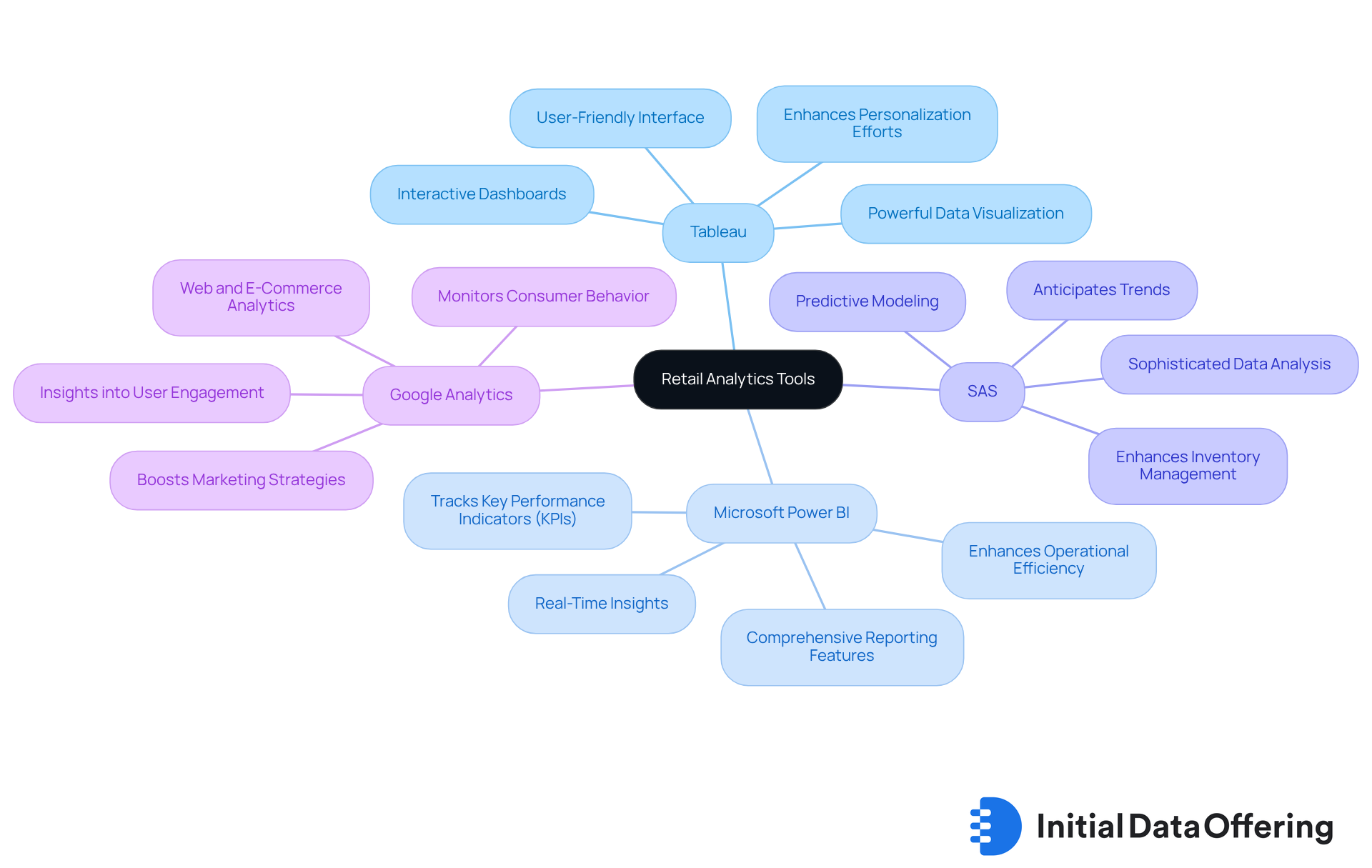
Conclusion
Retail data analysis is not just a trend; it is a fundamental component of successful business strategies in the retail sector. By harnessing the power of diverse datasets and advanced analytical methods, organizations can make informed decisions that enhance operational efficiency, customer satisfaction, and ultimately, profitability. The insights gained from effective retail data analysis empower businesses to adapt to market dynamics and consumer preferences, ensuring they remain competitive in an ever-evolving landscape.
Key concepts such as descriptive, diagnostic, predictive, and prescriptive analytics illustrate the importance of understanding and optimizing retail performance. These analytics provide features that allow businesses to analyze past performance, diagnose issues, predict future trends, and prescribe actions for improvement. The advantages of retail analytics extend beyond mere number crunching; they encompass improved decision-making, enhanced customer experiences, and strategic merchandising. Additionally, leveraging tools like Tableau and Microsoft Power BI can further streamline the analysis process, making data insights more accessible and actionable for retailers.
In conclusion, embracing retail data analysis is essential for any organization aiming to thrive in today's competitive environment. The call to action is clear: invest in the right tools and strategies to unlock the full potential of retail analytics. By doing so, businesses can not only enhance their market position but also foster lasting relationships with customers through personalized experiences and targeted engagement. The future of retail is data-driven, and those who adapt will undoubtedly reap the rewards.
Frequently Asked Questions
What is the Initial Data Offering (IDO) in retail?
The Initial Data Offering (IDO) is a resource that provides a diverse array of retail information, including alternative information, fundamentals information, and ESG information, empowering analysts to explore various aspects of retail performance and market dynamics.
How is the use of alternative information in retail data analysis expected to change by 2025?
By 2025, it is anticipated that around 67% of businesses will utilize alternative information for retail data analysis, highlighting its growing importance in the industry.
What benefits do organizations gain from leveraging the IDO marketplace?
Organizations can access unique datasets tailored to their analytical needs, which enhances their competitive edge and supports strategic decision-making in a rapidly evolving market.
What are the key concepts involved in retail data analysis?
The key concepts include:
- Descriptive analytics: Summarizes past performance.
- Diagnostic analytics: Explains why certain outcomes occurred.
- Predictive analytics: Forecasts future trends.
- Prescriptive analytics: Advises on actions based on insights.
How can retail analytics transform a retailer's approach?
By leveraging insights from retail data analysis, retailers can make informed decisions that improve operational efficiency and enhance customer satisfaction.
What are the main methods of retail data analysis?
The main methods include:
- Descriptive Analysis: Summarizes historical data to identify trends.
- Diagnostic Analysis: Investigates reasons behind past performance.
- Predictive Analysis: Forecasts future outcomes using historical data.
- Prescriptive Analysis: Suggests actions based on predictive insights.
How do these analytical methods impact decision-making in retail?
Each method serves unique purposes that significantly impact decision-making by providing insights into past behaviors, understanding underlying causes, anticipating future trends, and guiding informed actions that enhance performance and profitability.